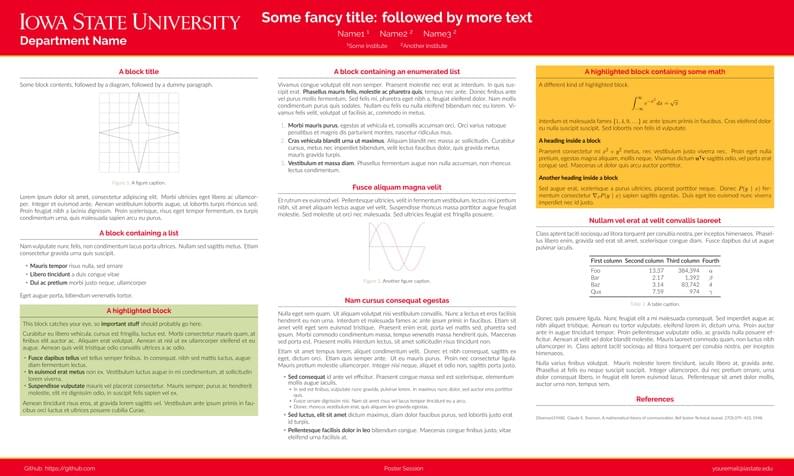LaTeX templates and examples — Posters
Showcase your work at conferences, class presentations, or university open days with these eye-catching LaTeX poster templates. Switch between landscape or portrait, A0, A1, A2, A3, and A4 size posters.
Recent

A LaTeX template for final project posters at ITNU, Ahmdedabad. Created using Gemini theme (https://github.com/anishathalye/gemini) and beamerposter

Vorlage für wissenschaftliche Poster (Format DIN A1) im Rahmen des Moduls "Vertiefendes Rechnerpraktikum zur Energietechnik" am Fachgebiet Energietechnik und Umweltschutz der Technischen Universität Berlin. Basierend auf der Latex-Klasse baposter von Brian Amberg und Reinhold Kainhofer (Licence GPL, (c) 2007-2011 ) Template for scientific posters (DIN A1) used in the course "Vertiefendes Rechnerpraktikum zur Energietechnik" at the Chair of Energy Engineering and Environmental Protection, Berlin Institute of Technology. Based on the latex-class baposter from Brian Amberg and Reinhold Kainhofer (Licence GPL, (c) 2007-2011 )

Diese Postervorlage kann zur Erstellung von Konferenzpostern im A0-Format für Posterpräsentationen benutzt werden. Die Vorlage enthält beispielhafte Aufzählungen, Gleichungen, Abbildungen, Tabellen, Zitate, einen QR-Code zum direkten Online-Zugriff und ein kurzes Literaturverzeichnis. Die Vorlage wurde am Lehrstuhl für Elektromagnetische Verträglichkeit am Institut für Medizintechnik entwickelt.

This poster template can be used to prepare conference posters in A0 format for poster presentations. The template contains exemplary itemizations, equations, figures, tables, citations, a QR code for direct download and a short list of references. The template has been developed at the Chair for Electromagnetic Compatibility at the Institute of Medical Engineering.

Yale unofficial poster template. Fork of another gemini poster template.

Poster template for Iowa State University. ISU poster template: https://www.print.iastate.edu/PrintingResources/DesignTemplates/ The template is a fork of gemini poster template: https://github.com/anishathalye/gemini See for more information: https://github.com/yonghyun-K/gemini-isu

Brown University color scheme for Gemini LaTeX beamerposter theme. brown - standard scheme with brown headings brownminimal - minimalistic and more printer-friendly variant Source: https://github.com/vskbellala/gemini-brown

Poster template for the Illinois Mathematics and Science Academy. Style guidelines obtained from: https://www.imsa.edu/marcom-toolkit/ Based on the Gemini theme (https://github.com/anishathalye/gemini).

Poster template following the corporate style of the Technical University of Delft (https://www.tudelft.nl/huisstijl)
\begin
Discover why over 20 million people worldwide trust Overleaf with their work.